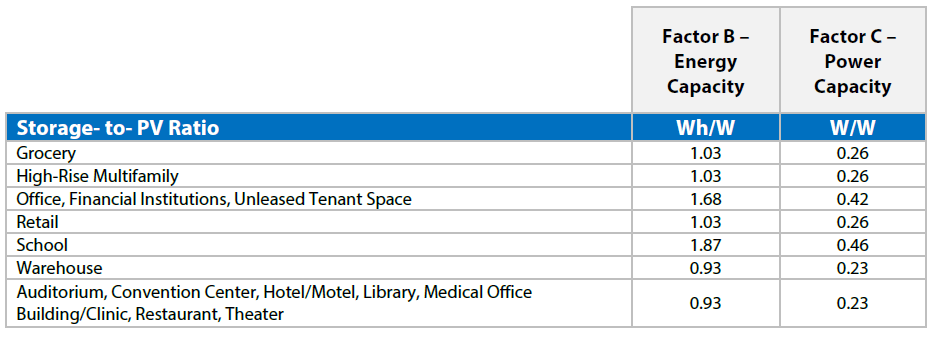California’s New SARA Requirements for PV Systems & Battery Storage
As we covered in our recent blog, Overview of 2022 Title 24, Part 6 Changes, the California Energy Code is implementing numerous changes on January 1, 2023. One of the biggest is a requirement for the installation of PV Systems and Battery Storage on new non-residential projects.
Here, we’ll go over the basic details of California’s New SARA Requirements for PV Systems & Battery Storage.
PV System Requirements
Previously, the code required that projects designate roof areas for future solar installations (Solar Ready) and reserve space for inverters, metering equipment, and pathways for conduits associated with a future PV system installation. Building on these previous requirements, Section 140.10 now defines new provisions, including an expanded sizing provision, called SARA (Solar Access Roof Area).
SARA includes the building’s roof area (capable of structurally supporting a PV system), and the roof areas of all covered parking areas, carports, and other newly constructed structures, capable of supporting a PV system.
For this code cycle, only new construction is affected, and only certain types of buildings need to meet the new requirements. The following lists which project types are affected:
- Grocery
- High-Rise Multifamily
- Office
- Financial Institutions
- Unleased Tenant Space
- Retail
- School
- Warehouse
- Auditorium
- Convention Center
- Hotel/Motel
- Library
- Medical Office Building/Clinic
- Restaurant
- Theater
For mixed occupancy buildings, containing one, or more, of the above building types (making up, at least, 80 percent of the floor area of the building), the total PV system capacity for the building is calculated using Equation 140.10-A (see below) for each of the above space types, then totaling them.
For compliance, the Joint Appendices* (specifically JA11) provide detailed definitions/instructions for System Orientation, Shading, Solar Access Verification, System Monitoring Requirements, Interconnection Requirements, Certificates and Availability, and Enforcement Agency.
*If you are not familiar with the Joint Appendices, they are the “How to” manual of the Title 24 code. The code may require a certain U-factor for a building assembly. One of the JA sections, devoted to that assembly, will define how to build it to meet the desired/required U-factor.

There are several exemptions/exceptions to the new SARA provisions:
- Any SARA capable area that receives less than 70 percent annual solar access (defined in 140.10(a)2, and JA11).
- Occupied roofs, according to the California Building Code, Section 503.1.4.
- A roof area that is unavailable, due to compliance with other building code requirements.
- Where the total of all available SARA is less than three percent of the conditioned floor area.
- Where the required PV system size is less than 4 kWdc.
- If the SARA size is less than 80 contiguous square feet.
- Buildings with enforcement-authority-approved roof designs, where the enforcement authority determines it is not possible to install a PV system.
- Multi-tenant buildings in areas where either a Virtual Net Metering (VNEM), or community solar program is unavailable.
The Solar Access Roof Area calculation is determined by the smaller result of the methods below:
Method 1 –
EQUATION 140.10-A PHOTOVOLTAIC DIRECT CURRENT SIZE
kWPVdc = (CFA x A)/1000
Where:
kWPVdc = Size of the PV system in kW.
CFA = Conditioned floor area in square feet.
A = PV capacity factor specified in Table 140.10-A for the building type (below).

Method 2 –
The second method for determining the PV size, is to total all available Solar Access Roof Areas (SARA), and then multiply it by 14 W/ft². Again, the smaller of the PV system sizes, determined by the two methods, is selected.
Battery Storage System Requirements
Buildings required by Section 140.10(a) to install a PV system, also need to have a battery storage system that meets the minimum qualification requirements of Reference Joint Appendix JA12. Like the PV systems, the Joint Appendices (JA 12) provide detailed definitions/instructions for Purpose and Scope, Qualification Requirements, Interconnection and Net Energy Metering Requirements, and Enforcement Agency.
The battery storage rated energy capacity, and rated power capacity are determined by Equation 140.10-B and Equation 140.10-C. As with PV, when the building contains more than one of the space types listed in Table 140.10-B, the rated energy capacity, and rated power capacity equations are run for each space type, and then totaled to get the total battery system capacity.
As with the PV system requirements, there are several exemptions to the provisions of 140.10(b):
- A battery storage system is not required, if the installed PV system size is less than 15 percent of the size determined by Equation 140.10-A.
- No battery storage system is required, when the building battery storage system’s rated capacity is less than 10 kWh.
- For multi-tenant buildings, the energy capacity and power capacity of the battery storage system is based on the tenant spaces with more than 5,000 square feet of conditioned floor area. For single-tenant buildings with less than 5,000 square feet of conditioned floor area, a battery storage system is required.
- In climate zone 1, a battery storage system is not required for offices, schools, and warehouses.
The size of the battery storage system is determined by the calculations below:
EQUATION 140.10-B-BATTERY STORAGE RATED ENERGY CAPACITY
kWhbatt = kWPVdc x B/D0.5
Where:
kWhbatt = Rated Useable Energy Capacity of the battery storage system in kWh.
kWPVdc = PV system capacity required by section 140.10(a) in kWdc.B = Battery energy capacity factor specified in Table 140.10-B for the building type.
D = Rated single charge-discharge cycle AC to AC (round-trip) efficiency of the battery storage system.
EQUATION 140.10-C-BATTERY STORAGE RATED POWER CAPACITY
kWbatt = kWPVdc x C
Where:
kWbatt = Power capacity of the battery storage system in kWdc.
kWPVdc = PV system capacity required by section 140.10(a) in kWdc.
C = Battery power capacity factor specified in Table 140.10-B for the building type.

One other option for meeting the PV System, and Battery Storage System Requirements is through Community Shared Solar Electric Generation System or Battery Storage System Offset.
If approved by the commission, community shared solar systems, other community shared renewable systems, community shared battery storage systems, or combination of these systems can be used to comply partially, or totally, with the PV System, and Battery Storage System Requirements of Sections 140.0(c), 150.1(a)3, or 170.0(a)3 of Title 24.
Bottom Line
There are significant amendments to the California Energy Code that take effect on January 1, 2023. The installation of Photovoltaic Systems and Battery Storage on new non-residential projects is among the greatest. In comparison to earlier codes, compliance will be more difficult, but the state promises new tools to make the task less difficult. We will review those tools, as they become available.
Fortunately, there is still time to learn and adapt to the new provisions before January 1, 2023. Thankfully, many of the code books, Joint Appendices, software, and forms are already on the California Energy Commission website. Several are still in draft form, but are still good references on the coming changes. However, the final versions of the compliance manuals are available and are simplified versions of the code, and a great resource. Lastly, Energy Code Ace has an online version of the code book, as well as Fact Sheets, Trigger Sheets, and tools to make the code more accessible.
If you have any questions or need help with understanding California’s New SARA Requirements for PV Systems & Battery Storage, please contact our experienced team at Schnackel Engineers.
Comments